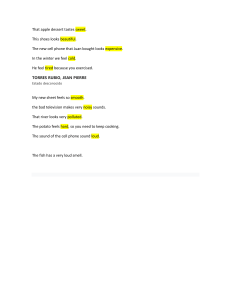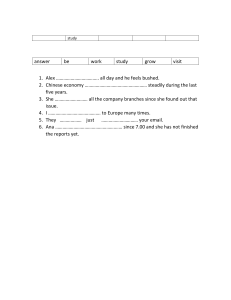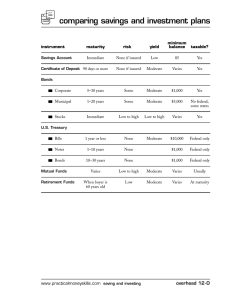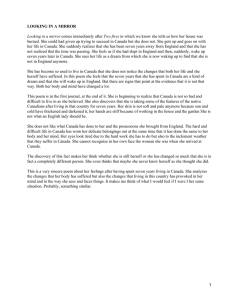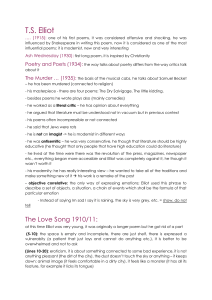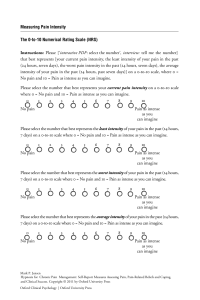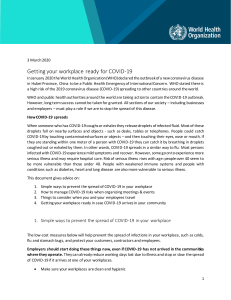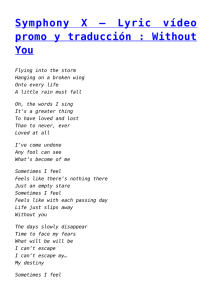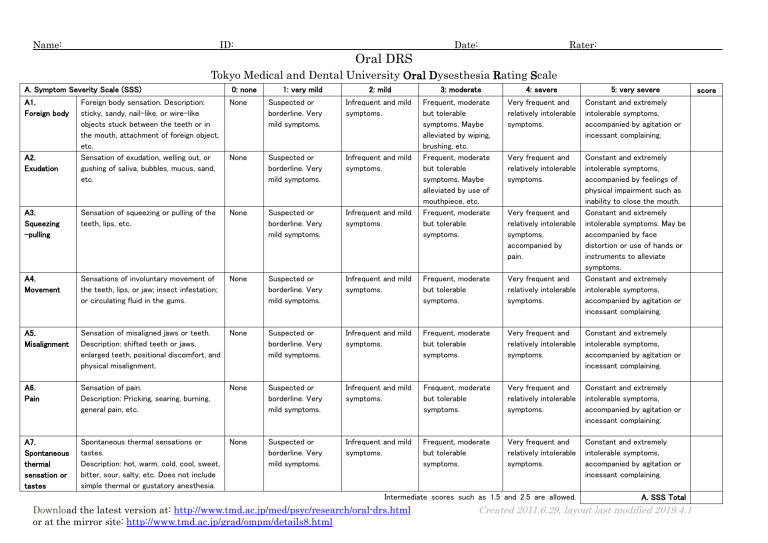
Name: ID: Oral DRS Date: Rater: Tokyo Medical and Dental University Oral Dysesthesia Rating Scale A. Symptom Severity Scale (SSS) 0: none A1. Foreign body Foreign body sensation. Description: sticky, sandy, nail-like, or wire-like objects stuck between the teeth or in the mouth, attachment of foreign object, etc. Sensation of exudation, welling out, or gushing of saliva, bubbles, mucus, sand, etc. None Suspected or borderline. Very mild symptoms. Infrequent and mild symptoms. None Suspected or borderline. Very mild symptoms. Infrequent and mild symptoms. A3. Squeezing -pulling Sensation of squeezing or pulling of the teeth, lips, etc. None Suspected or borderline. Very mild symptoms. Infrequent and mild symptoms. A4. Movement Sensations of involuntary movement of the teeth, lips, or jaw; insect infestation; or circulating fluid in the gums. None Suspected or borderline. Very mild symptoms. A5. Misalignment Sensation of misaligned jaws or teeth. Description: shifted teeth or jaws, enlarged teeth, positional discomfort, and physical misalignment. None A6. Pain Sensation of pain. Description: Pricking, searing, burning, general pain, etc. A7. Spontaneous thermal sensation or tastes Spontaneous thermal sensations or tastes. Description: hot, warm, cold, cool, sweet, bitter, sour, salty, etc. Does not include simple thermal or gustatory anesthesia. A2. Exudation 1: very mild 2: mild 4: severe 5: very severe Frequent, moderate but tolerable symptoms. Maybe alleviated by wiping, brushing, etc. Frequent, moderate but tolerable symptoms. Maybe alleviated by use of mouthpiece, etc. Frequent, moderate but tolerable symptoms. 3: moderate Very frequent and relatively intolerable symptoms. Constant and extremely intolerable symptoms, accompanied by agitation or incessant complaining. Very frequent and relatively intolerable symptoms. Infrequent and mild symptoms. Frequent, moderate but tolerable symptoms. Very frequent and relatively intolerable symptoms. Constant and extremely intolerable symptoms, accompanied by feelings of physical impairment such as inability to close the mouth. Constant and extremely intolerable symptoms. May be accompanied by face distortion or use of hands or instruments to alleviate symptoms. Constant and extremely intolerable symptoms, accompanied by agitation or incessant complaining. Suspected or borderline. Very mild symptoms. Infrequent and mild symptoms. Frequent, moderate but tolerable symptoms. Very frequent and relatively intolerable symptoms. Constant and extremely intolerable symptoms, accompanied by agitation or incessant complaining. None Suspected or borderline. Very mild symptoms. Infrequent and mild symptoms. Frequent, moderate but tolerable symptoms. Very frequent and relatively intolerable symptoms. Constant and extremely intolerable symptoms, accompanied by agitation or incessant complaining. None Suspected or borderline. Very mild symptoms. Infrequent and mild symptoms. Frequent, moderate but tolerable symptoms. Very frequent and relatively intolerable symptoms. Constant and extremely intolerable symptoms, accompanied by agitation or incessant complaining. Very frequent and relatively intolerable symptoms, accompanied by pain. Intermediate scores such as 1.5 and 2.5 are allowed. Download the latest version at: http://www.tmd.ac.jp/med/psyc/research/oral-drs.html or at the mirror site: http://www.tmd.ac.jp/grad/ompm/details8.html A. SSS Total Created 2011.6.29, layout last modified 2019.4.1 score Name: ID: B. Functional Impairment Scale (FIS) 0: none Date: 1: very mild B1. Eating Disturbance of eating function and altered dietary preference. None Feels some difficulty but eats normally. B2. Articulation Disturbance of speech or articulation. None B3. Work Disturbance of social function/work. Examples: housework for a homemaker and schoolwork for a student. Not limited to disturbance due to oral dysesthesia. Disturbance of interpersonal (e.g., meeting friends, going out) or recreational (e.g., reading, exercise) activities. Not limited to disturbance due to oral dysesthesia. None Feels some difficulty in speech or articulation, but sounds normal to others. Feels some difficulty but performs normally. B4. Social Activities Close to 100% None Close to 100% Greater than 90% Feels some difficulty but performs normally. Greater than 90% Rater: 2: mild 3: moderate 4: severe 5: very severe Feels mild difficulty. Somewhat decreased ingestion. Altered dietary preference, e.g., avoids sticky foods. Feels mild difficulty in speech or articulation. Sounds somewhat unnatural to others. Feels moderate difficulty. Significantly decreased ingestion. Some decrease in body weight. Feels moderate difficulty in speech or articulation. Sounds awkward and indistinct. Feels moderate difficulty. Significant decline in efficiency. Feels severe difficulty. Significantly decreased body weight. Impossible to eat. Needs gastrostomy or parenteral nutrition. Feels severe difficulty in speech or articulation. Prominently awkward and indistinct. Feels severe difficulty. Prominent decline in efficiency. Hard to continue. “Less than 30%” Impossible to speak or articulate. Gives up spontaneous speech. Feels mild difficulty with mild decline in efficiency. “About 50%” “About 80%” 89–70% Feels mild difficulty. Mild decline in activity. “About 50%” “About 80%” 89–70% 69–30% Feels moderate difficulty. Significant decline in activity. >29% Feels severe difficulty. Prominent decline in activity. Hard to continue. “Less than 30%” >29% 69–30% Intermediate scores such as 1.5 and 2.5 are allowed. Download the latest version at: http://www.tmd.ac.jp/med/psyc/research/oral-drs.html or at the mirror site: http://www.tmd.ac.jp/grad/ompm/details8.html Score No potential to perform. Almost 0% No potential to perform. Almost 0% B. FIS Total Created 2011.6.29, layout last modified 2019.4.1 Name: ID: Date: Rater: C. Visual Analog Scale (VAS) C1. Considering your experiences, how severe are your present symptoms? No symptoms Extremely severe mm C2. Compared to the baseline (before treatment), how much have your symptoms improved or worsened? Worse Better mm Download the latest version at: http://www.tmd.ac.jp/med/psyc/research/oral-drs.html or at the mirror site: http://www.tmd.ac.jp/grad/ompm/details8.html Created 2011.6.29, layout last modified 2019.4.1 Name: ID: Date: Rater: (Note) Oral Dysesthesia Rating Scale: A tool for assessing psychosomatic symptoms in oral regions Uezato et al. BMC Psychiatry 2014, 14:359 Article URL: http://www.biomedcentral.com/1471-244X/14/1696 Tokyo Medical and Dental University Graduate School Department of Psychiatry and Behavioral Sciences 1-5-45, Yushima, Bunkyo-ku, Tokyo 113-8519, Japan E-mail: [email protected] Download the latest version at: http://www.tmd.ac.jp/med/psyc/research/oral-drs.html or at the mirror site: http://www.tmd.ac.jp/grad/ompm/details8.html Created 2011.6.29, layout last modified 2019.4.1
